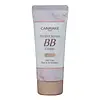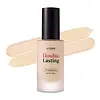Canmake Perfect Serum BB Cream SPF 50+ PA+++ Versus Etude House Double Lasting Foundation SPF 35 PA++
What's inside
What's inside
 Key Ingredients
Key Ingredients

 Benefits
Benefits

 Concerns
Concerns

 Ingredients Side-by-side
Ingredients Side-by-side

Butylene Glycol
HumectantGlycerin
HumectantPropanediol
SolventDiglycerin
HumectantAscorbyl Glucoside
AntioxidantArbutin
AntioxidantCeramide NP
Skin ConditioningGlycosyl Trehalose
Emulsion StabilisingHydrogenated Starch Hydrolysate
HumectantMarrubium Vulgare Extract
Skin ConditioningHydrolyzed Prunus Domestica
Skin ConditioningHydrolyzed Silk
HumectantSaxifraga Sarmentosa Extract
Skin ConditioningGinkgo Biloba Leaf Extract
Skin ConditioningPrunus Yedoensis Leaf Extract
Skin ConditioningHamamelis Virginiana Leaf Extract
Skin ConditioningRosa Multiflora Fruit Extract
MaskingBetula Alba Bark Extract
MaskingChondrus Elatus/Saccharina Angustata/Monostroma Nitidum Thallus Extract
Skin ConditioningSodium Hyaluronate
HumectantPrunus Persica Leaf Extract
EmollientRoyal Jelly Extract
Skin ConditioningGlycine Soja Seed Extract
Skin ConditioningCoix Lacryma-Jobi Ma-Yuen Seed Extract
Skin ConditioningSoluble Collagen
HumectantVaccinium Myrtillus Leaf Extract
AstringentCynara Scolymus Leaf Extract
Skin ConditioningSqualane
EmollientC13-15 Alkane
SolventButylene Glycol, Glycerin, Propanediol, Diglycerin, Ascorbyl Glucoside, Arbutin, Ceramide NP, Glycosyl Trehalose, Hydrogenated Starch Hydrolysate, Marrubium Vulgare Extract, Hydrolyzed Prunus Domestica, Hydrolyzed Silk, Saxifraga Sarmentosa Extract, Ginkgo Biloba Leaf Extract, Prunus Yedoensis Leaf Extract, Hamamelis Virginiana Leaf Extract, Rosa Multiflora Fruit Extract, Betula Alba Bark Extract, Chondrus Elatus/Saccharina Angustata/Monostroma Nitidum Thallus Extract, Sodium Hyaluronate, Prunus Persica Leaf Extract, Royal Jelly Extract, Glycine Soja Seed Extract, Coix Lacryma-Jobi Ma-Yuen Seed Extract, Soluble Collagen, Vaccinium Myrtillus Leaf Extract, Cynara Scolymus Leaf Extract, Squalane, C13-15 Alkane
Water
Skin ConditioningCyclopentasiloxane
EmollientCI 77891
Cosmetic ColorantTrimethylsiloxysilicate
EmollientCyclohexasiloxane
EmollientTitanium Dioxide
Cosmetic ColorantCaprylyl Methicone
Skin ConditioningButylene Glycol
HumectantPEG/PPG-18/18 Dimethicone
EmulsifyingCI 77492
Cosmetic ColorantMica
Cosmetic ColorantSodium Chloride
MaskingDimethicone/Vinyl Dimethicone Crosspolymer
Skin ConditioningDisteardimonium Hectorite
StabilisingPolymethylsilsesquioxane
PEG-10 Dimethicone
Skin ConditioningAlumina
AbrasiveAluminum Hydroxide
EmollientPentylene Glycol
Skin Conditioning1,2-Hexanediol
Skin ConditioningCI 77491
Cosmetic ColorantTriethoxycaprylylsilane
Parfum
MaskingCaprylyl Glycol
EmollientGlyceryl Caprylate
EmollientCI 77499
Cosmetic ColorantSimethicone
EmollientXanthan Gum
EmulsifyingDisodium EDTA
Methicone
EmollientBoron Nitride
AbsorbentMethyl Methacrylate Crosspolymer
Tin Oxide
AbrasiveWater, Cyclopentasiloxane, CI 77891, Trimethylsiloxysilicate, Cyclohexasiloxane, Titanium Dioxide, Caprylyl Methicone, Butylene Glycol, PEG/PPG-18/18 Dimethicone, CI 77492, Mica, Sodium Chloride, Dimethicone/Vinyl Dimethicone Crosspolymer, Disteardimonium Hectorite, Polymethylsilsesquioxane, PEG-10 Dimethicone, Alumina, Aluminum Hydroxide, Pentylene Glycol, 1,2-Hexanediol, CI 77491, Triethoxycaprylylsilane, Parfum, Caprylyl Glycol, Glyceryl Caprylate, CI 77499, Simethicone, Xanthan Gum, Disodium EDTA, Methicone, Boron Nitride, Methyl Methacrylate Crosspolymer, Tin Oxide
Alternatives
Ingredients Explained
These ingredients are found in both products.
Ingredients higher up in an ingredient list are typically present in a larger amount.
Butylene Glycol (or BG) is used within cosmetic products for a few different reasons:
Overall, Butylene Glycol is a safe and well-rounded ingredient that works well with other ingredients.
Though this ingredient works well with most skin types, some people with sensitive skin may experience a reaction such as allergic rashes, closed comedones, or itchiness.
Learn more about Butylene Glycol